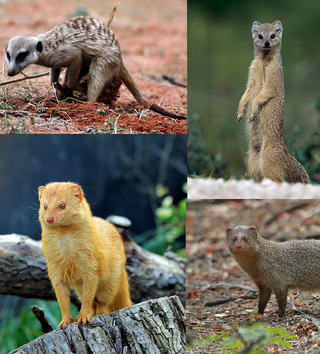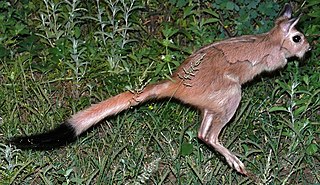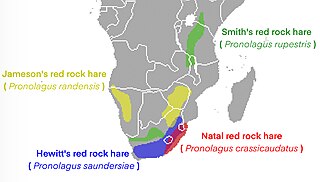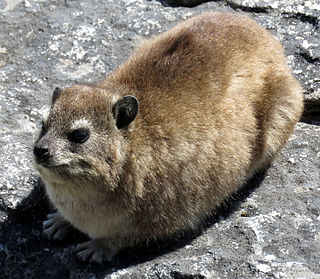
Canidae is a biological family of dog-like carnivorans, colloquially referred to as dogs, and constitutes a clade. A member of this family is also called a canid. The family includes three subfamilies: the Caninae, and the extinct Borophaginae and Hesperocyoninae. The Caninae are known as canines, and include domestic dogs, wolves, coyotes, foxes, jackals and other species.

Marsupials are a diverse group of mammals belonging to the infraclass Marsupialia. They are natively found in Australasia, Wallacea, and the Americas. One of the defining features of marsupials is their unique reproductive strategy, where the young are born in a relatively undeveloped state and then nurtured within a pouch on their mother's abdomen.

The hippopotamus (; pl.: hippopotamuses; often shortened to hippo, further qualified as the common hippopotamus, Nile hippopotamus, or river hippopotamus, is a large semiaquatic mammal native to sub-Saharan Africa. It is one of only two extant species in the family Hippopotamidae, the other being the pygmy hippopotamus. Its name comes from the ancient Greek for "river horse".

The meerkat or suricate is a small mongoose found in southern Africa. It is characterised by a broad head, large eyes, a pointed snout, long legs, a thin tapering tail, and a brindled coat pattern. The head-and-body length is around 24–35 cm (9.4–13.8 in), and the weight is typically between 0.62 and 0.97 kg. The coat is light grey to yellowish-brown with alternate, poorly-defined light and dark bands on the back. Meerkats have foreclaws adapted for digging and have the ability to thermoregulate to survive in their harsh, dry habitat. Three subspecies are recognised.

A mongoose is a small terrestrial carnivorous mammal belonging to the family Herpestidae. This family has two subfamilies, the Herpestinae and the Mungotinae. The Herpestinae comprises 23 living species that are native to southern Europe, Africa and Asia, whereas the Mungotinae comprises 11 species native to Africa. The Herpestidae originated about 21.8 ± 3.6 million years ago in the Early Miocene and genetically diverged into two main genetic lineages between 19.1 and 18.5 ± 3.5 million years ago.

The dire wolf is an extinct canine. The dire wolf lived in the Americas during the Late Pleistocene and Early Holocene epochs. A putative, controversial fossil was recently reported from northeast China, but other researchers questioned the taxonomic attribution of this specimen. The species was named in 1858, four years after the first specimen had been found. Two subspecies are recognized: Aenocyon dirus guildayi and Aenocyon dirus dirus. The largest collection of its fossils has been obtained from the Rancho La Brea Tar Pits in Los Angeles.

Paenungulata is a clade of "sub-ungulates", which groups three extant mammal orders: Proboscidea, Sirenia, and Hyracoidea (hyraxes). At least two more possible orders are known only as fossils, namely Embrithopoda and Desmostylia.

The bat-eared fox is a species of fox found on the African savanna. It is the only extant species of the genus Otocyon and an ancient (basal) canid species. Fossil records indicate this canid first appeared during the middle Pleistocene. There are two separate populations of the bat-eared fox, each of which makes up a subspecies. The bat referred to in its colloquial name is possibly the Egyptian slit-faced bat, which is abundant in the region and has very large ears. Other vernacular names include big-eared fox, black-eared fox, long-eared fox, Delalande's fox, cape fox, and motlosi.

The brown hyena, also called strandwolf, is a species of hyena found in Namibia, Botswana, western and southern Zimbabwe, southern Mozambique and South Africa. It is the only extant species in the genus Parahyaena. It is currently the rarest species of hyena. The largest remaining brown hyena population is located in the southern Kalahari Desert and coastal areas in Southwest Africa. The global population of brown hyena is estimated by IUCN at a number between 4,000 and 10,000 and its conservation status is marked as near threatened in the IUCN Red List.

Pedetes is a genus of rodent, the springhares, in the family Pedetidae. Members of the genus are distributed across southern and Eastern Africa.

Ekorus ekakeran is a large, extinct mustelid mammal. Fossils, including largely complete skeletons, are known from the late Miocene of Kenya.

Metailurus is a genus of saber-toothed cat in the family Felidae, and belonging to the tribe Metailurini, which occurred in North America, Eurasia and Africa from the Miocene to the Middle Pleistocene.

Feliformia is a suborder within the order Carnivora consisting of "cat-like" carnivorans, including cats, hyenas, mongooses, viverrids, and related taxa. Feliformia stands in contrast to the other suborder of Carnivora, Caniformia.

The red rock hares are the four species in the genus Pronolagus. They are African lagomorphs of the family Leporidae.

Suricata is a genus of mongoose that is endemic to Africa. The oldest species known is the extinct Suricata major that lived about 1.8 million years ago in South Africa. The only species alive is the meerkat.

Hyraxes, also called dassies, are small, stout, herbivorous mammals in the family Procaviidae within the order Hyracoidea. Hyraxes are well-furred, rotund animals with short tails. Modern hyraxes are typically between 30 and 70 cm in length and weigh between 2 and 5 kg. They are superficially similar to marmots, or over-large pikas, but are much more closely related to elephants and sirenians. Hyraxes have a life span from nine to 14 years. Both types of "rock" hyrax live on rock outcrops, including cliffs in Ethiopia and isolated granite outcrops called koppies in southern Africa.

Syncerus antiquus is an extinct species of buffalo from the Late Pleistocene and Holocene of Africa. It was one of the largest species in its family, potentially weighing up to 2,000 kilograms (4,400 lb). Due to this fact, it is sometimes known as the African giant buffalo. The time of its extinction is of debate; Syncerus antiquus either became extinct at the end of the Late Pleistocene about 12,000 years ago or during the Holocene, some 4,000 years ago.

A tripod stance is a behaviour in which quadruped animals rear up on their hind legs and use their tail to support this position. Several animals use this behaviour to improve observation or surveillance, and during feeding, grooming, thermoregulation, or fighting.
Hippotragus gigas is an extinct species of antelope known from the Plio-Pleistocene of Africa.

















